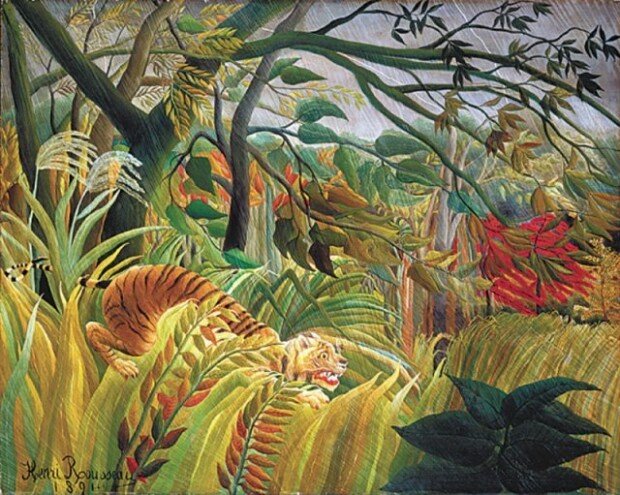Surviving in a jungle
Surviving in a jungle
Posted January. 06, 2022 07:58,
Updated January. 06, 2022 07:58

The painting of Henri Rousseau depicts a jungle. On a stormy day, a tiger who is crouching perhaps due to the lightning or to hunt a prey, is moving forward. What is the wide-eyed beast, bearing its sharp teeth, after?
Rousseau was a tax collector whose hobby was to paint. He became a full-time artist after retiring as a tax collector at age 49. Though he was ridiculed as a Sunday painter, he continued to pursue his dream by entering salons such as the Independent. He was not artfully skilled as he was not professionally trained as an artist, but he created his own unique skills. This painting was one of his first 20 jungle paintings that made him famous.
When the painting was exhibited for the first time, it was criticized as childish but also praised for its exotic theme and unique composition. The jungle in the painting depicts a Mexican jungle. Rousseau claimed that he had been to a Mexican jungle during military service, but he had never set foot out of France. He had visited the Jardin des Plantes of Paris to observe the details of the tropical plants in the painting. He painted the tiger after visiting the Paris Exposition Universelle, where there was a stuffed tiger. The painting was created through imagination.
The title “Surprised!” also inspires imagination. Art critics say that the title refers to the tiger surprising the prey, but the prey is not actually depicted in the painting. Rousseau himself had described the tiger as “seeking after an explorer”. A gunned explorer might have been standing next to the tiger.
Who would be more scared, a tiger or a human, if they had encountered each other in a jungle? To a tiger, humans, instead of other predators, might be the most intimidating. Surviving in a jungle requires strength, be it with weapons, power, or wisdom. An explorer without any preparation will be captured by a tiger if s/he does not make thorough preparations beforehand. Likewise, Rousseau was able to survive in the competitive art community due to his imagination and uniqueness.
Headline News
- Joint investigation headquarters asks Yoon to appear at the investigation office
- KDIC colonel: Cable ties and hoods to control NEC staff were prepared
- Results of real estate development diverged by accessibility to Gangnam
- New budget proposal reflecting Trump’s demand rejected
- Son Heung-min scores winning corner kick







